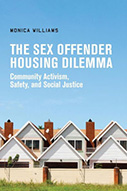The Sex Offender Housing Dilemma: Community Activism, Safety, And Social Justice

Author: Monica Williams
Publisher: New York: New York University Press, 2018. 287p.
Reviewer: Richard Tewksbury | July 2018
One of the problems with many criminal justice policies is that when we find a way to address one problem we often create (at least) one more problem for the system. In the case of concerns about sexual offenders and a desire to protect society from the harms they bring, the “solution” of sex offender registration and community notification was created. However, as has been addressed by numerous scholars, these policies have created myriad negative consequences, for criminal justice agencies and actors, sex offenders themselves, and as Monia Williams demonstrates in The Sex Offender Housing Dilemma, entire communities. Knowing who in our communities has been convicted of sexual offenses may be beneficial for some, but as clearly shown in this book, so too does this knowledge lead to public fear, consternation and on the positive side, some enhanced community cohesion and social activism.
The problem of where to house the most serious of sex offenders is the issue that Williams takes on directly. Through three intensive case studies of California communities slated to receive sexual offenders being released from prison readers learn of how concerns may be translated into resistance. So too are readers shown how some communities fail to develop a common goal and means for resistance, and hence fail in their efforts to keep such social pariahs out of their communities.
While this book is an excellent examination of how communities can and do (or do not) coalesce and collectively work in response to the perceived threat of a sexual predator moving in next door, this is really not a criminal justice or criminology book. This is a great book about social movements and collective behavior. I wish I had read this book years ago in graduate school. This book would have been made clear the ways that collective action can develop and how community organizing operates. The intricacies of how contextual elements of politics, community economics, geography, and population demographics all influence official action and implementation of social policies are what is at the center of Williams’ examination.
On the criminal justice front, Williams shows us (once again) that societal reactions to sexual offenders is universally negative, driven by fear, stigma and fueled by popular media accounts of such crimes and offenders. What is added to this discussion, however, is the varying degrees and forms that such fears and stigma take. Then, in turn how different perceptions, by different populations, yields different collective actions (or lack of actions).
In the end, this is a really good book. At points it is thick with theory, but it is also always grounded in the intensive fieldwork Williams completed. While highly informative, though, this book is unlikely to find its true audience. Criminal justice scholars will not find much new here, although for those of us trained in a sociological tradition it will certainly rekindle many of those core sociological ideas about community structure, social organization and collective action. In that regard, criminal justice and criminology scholars will benefit from reading The Sex Offender Housing Dilemma, the benefits will just probably not be what readers anticipated when starting the book.
Richard Tewksbury, Arizona State University


